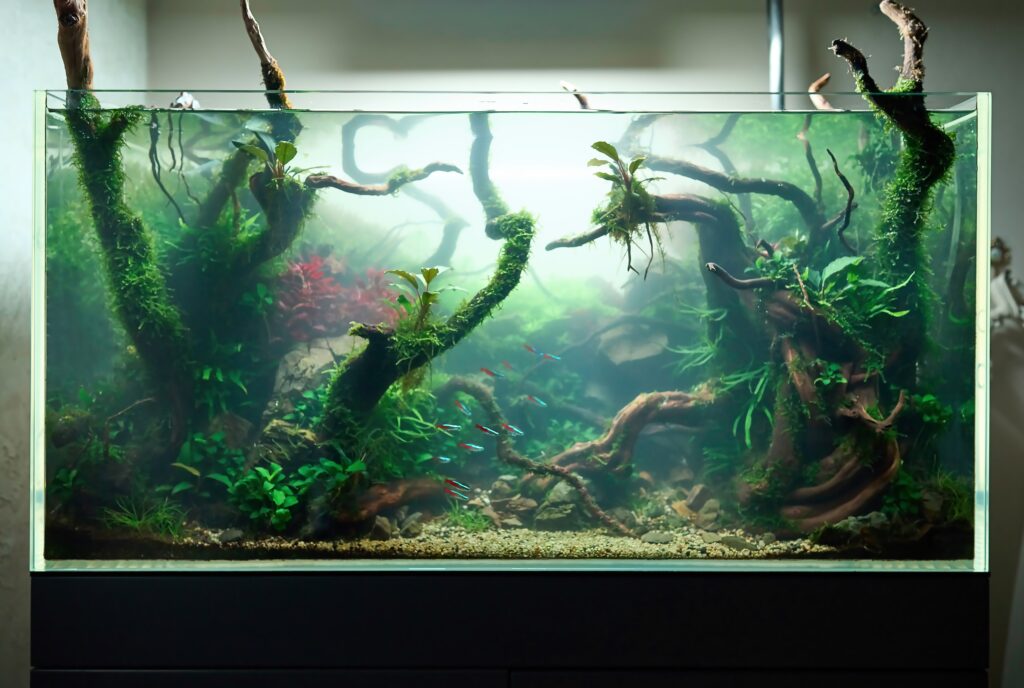Cloudy water in a fish tank – regardless of what caused it – is a bacterial bloom. Getting to the root of the problem and resolving that issue is the only way to truly resolve it so that it does not become a chronic issue. Also, you will have crystal clear water! 🙂 First let’s talk a look at what causes a bacterial bloom so that I can help you trouble shoot your tank’s specific issue and then I’ll show you how to resolve it.

Why New Fish Tanks Get Cloudy
As the good bacteria reproduce and colonize in your aquarium, they essentially “bloom”. This bloom gives off ammonia and nitrates. As the bacteria colonies settle, the cloudiness of your tank will clear up. If you aquarium is established – meaning not new – if you experience a bacterial bloom it can be a few factors: overfeeding, a deceased fish, too many fish in one aquarium, not having a large enough biological filtration system, or you could be using too many additives that are not allowing the aquarium to complete its cycle properly. Let’s take a deeper look into each issue.
How to Tell if You Are Overfeeding Your Fish Tank
Uneaten food – aside from overcrowding – is probably the most common cause of a bacterial bloom. When you feed your fish, start off with a small amount and see how much is consumed in one minute. If there is still a lot of food on the substrate or floating in the water column, you have overfed your fish. To avoid this, feed small amounts every minute or so until all of your fish have eaten. Once you see them not consuming as much food, that feeding session should end there. This can be a bit tricky at first, but if you spend the time and pace yourself, you will resolve this issue fairly quickly. As your fish grow, they will need to consume more food. So be sure to monitor this on an ongoing basis to ensure that you are feeding them enough – but not too much.
Is Your Fish Tank Overcrowded?
The general rule of thumb is 1 inch of fish per gallon. So a 3 inch fish should be in at least 3 gallons of water. I am from the school of thought of under stocking my aquariums so that the fish’s waste does not become a problem. Take an inventory of the fish that are currently in your aquarium and their sizes. Add them all up and if you have more inches in fish than gallons. If so – it’s time to upgrade your aquarium.
Does Your Fish Tank Have a Large Enough Biofilter?
A lot of aquariums have the hang on filters that have the “bio-wheels” in them – and that’s it. These hang on filters are primarily for mechanical filtration. So you will need a dedicated biological filter in addition to mechanical and chemical filtration in your aquarium. In other words, just a hang on filter will not suffice. They just don’t provide enough surface area for the bacteria to colonize significantly enough. I prefer canister filters for biological filtration. I currently am running a Marineland PC-ML530 Multi-Stage Canister Filter on my 300 gallon shark pond and a Marineland Magniflow Canister Filter 220 GPH on my 40 gallon freshwater – mostly fancy tail guppy – freshwater aquarium.

I have also used Ehiem canister filters in the past and I really like that brand as well.

So based on your aquarium’s size and how many times per hour you need your water to pass through the canister filter will determine the right size for your aquarium. Also, the type of species that you are keeping and their tolerance to water flow should be considered as well. These canister filters also have a place to store chemical filtration for example, carbon as well which is a bonus.
When to Use Emergency Additives

If you have a bacteria bloom and you use a nitrate or ammonia neutralizer, you could be disrupting your aquarium’s natural nitrogen cycle. This is where the ammonia gets turned into nitrite and then nitrate during the cycle. If you do not allow the ammonia to turn into nitrite and then into nitrate, you are just prolonging the inevitable. For this reason, I recommend that you only use these additives in emergencies where you are losing fish or something unusual happens. It’s also a good idea to have a quarantine tank set up incase you need to remove some of the fish from your aquarium until the situation is under control and they need a temporary home until you resolve their main home’s issue.
You can learn how to set up a quarantine aquarium here: How to Set up an Aquarium Quarantine Tank
